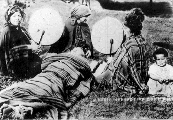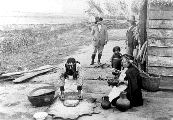 |
  |
|
Chile is characterized for having a large geographical and climatic diversity along its territory. When studying the different native groups that inhabited the country it is necessary to know these characteristics. Such diversity favored the development of human groups whose survival was ensured according to the degree of adaptability reached in the landscape and the climate. However, the groups with the highest cultural development were those who received direct Inca influence (north of Chile) and those who established in societies upheld on agriculture and cattle breeding, activities promoted by the fertile central valleys. The mapuche culture responds to this reality.
It is well known that before the European invasion, the mapuche population spread out between the present city of Copiapó and the archipelago of Chiloé. However, when the Spaniards arrived, the population was mainly concentrated between the Bío-Bío and Toltén rivers, south of which and up to Chiloé, there existed a zone with a clear mapuche cultural influence.
The denomination mapuche (people of the earth) designates an identical cultural and ethnic group. Nevertheless, this unity responds to a cultural concept not to a political concept. Although the customs, language and ethnic characteristics repeat themselves, the social organization is characterized for being constituted by different lof (groups of consanguineous relatives who lived gathered in communities and obeyed only to one lonko or headman) independent between them and constituted by approximately 15 to 20 families, that kept up local peculiarities. This dispersion is explained by the strong mapuche belief that death does not occur due to natural causes but it is the consequence of spells cast by enemies of the deceased. When death occurs, the machi, communicating with the spirits, discovered the identity of the person to blame for the spells, who often took the form of a bird or an animal, which explained the impossibility of its human locality. This caused constant and repeated confrontations among lof, since the spell rarely proceeded from the same tribe.
In turn, these lof gathered in three parallel geographical zones known as butal-mapu. These zones extended vertically and approximatly between the Bío-Bío and Toltén rivers, disposed according to the surrounding topography: the zone corresponding to Los Andes range and its skirts, inapire-mapu (sub-Andean country); the territory of intermediate valleys, lelfun-mapu (plain country), and the lands between the coast range and the Pacific Ocean, lafquen-mapu (maritime country).
Further to the butal-mapu, the mapuches made distinctions among the different human groups that existed in the territory according to their geographical location, calling the northern tribes pikunches (northern people) and the southern tribes huilliches (southern people), designations that distinguished the inhabitants of the zones encompassed between Copiapó and Bío-Bío and between Bío-Bío and Chiloé, respectively. Anthropologic studies consider that, although some other human groups originally inhabited those regions, the mapuches succeeded in imposing their culture. This is evidenced, among other aspects, by the linguistic unity that existed among the pehuenches, changos and tehuelches, whose mother tongue is the mapudungun or variations of the same.
Paula Carvajal Améstica.
Bibliography:
- Medina, José Toribio, Los Aborígenes de Chile, Santiago-Chile, Ediciones Imprenta Universitaria,1952.
- Castedo, Leopoldo; Encina,Francisco, Historia de Chile, 14° edition, Santiago-Chile, Editorial Lord Cochrane, 1982.
Sitio desarrollado por SISIB - Universidad de Chile